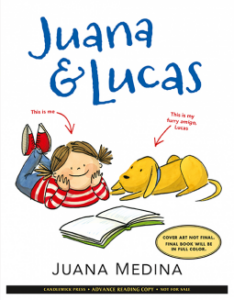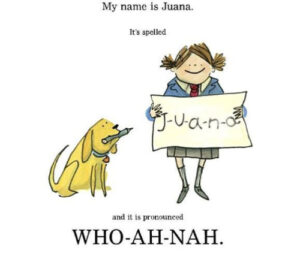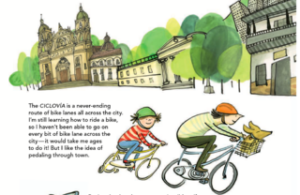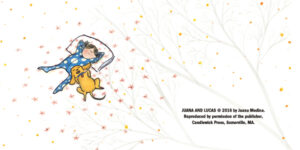 Juana and Lucas
Juana and Lucas
By Juana Medina
Candlewick Press
$14.99
ISBN: 978-1-7636-7208-9
Ages 6-9
On shelves now
Windows. Mirrors. Mirrors. Windows. Windowy mirrors. Mirrory windows. Windows. Mirrors. Sliding doors! Mirrors. Windows.
In the world of 21st century children’s literature, diversity should be the name of the game. We want books for our children that reflect the worlds they know and the worlds they have yet to greet. We want them to see themselves in their books (mirrors), see others unlike themselves (windows), and have a way to get from one place to another (sliding doors). To accomplish this, all you have to do is publish a whole bunch of books about kids of different races, religions, abilities, persuasions, you name it. Great strides have been made over the last few years in the general consciousness of the publishing industry (the publishers, the librarians, the teachers, and even the parents) even as teeny tiny, itty bitty, itsy bitsy tiptoes have been made in terms of what actually is getting published. Much of the credit for spearheading efforts to bring to light more and more books for all children can be given to the We Need Diverse Books movement. That said, our children’s rooms are still filled with monumental gaps. Contemporary Jewish characters are rare. Muslim characters rarer still. And don’t even TALK to me about the state of kids in wheelchairs these days. Interestingly enough, the area where diversity has increased the most is in early chapter books. Whether it’s Anna Hibiscus, Lola Levine, Alvin Ho, or any of the other new and interesting characters out there, there is comfort to be found in those books that transition children from easy readers to full-blown novels. Into this world comes Juana Medina and her semi-autobiographical series Juana & Lucas. Short chapters meet universal headaches (with details only available in Bogota, Colombia) ultimately combining to bring us a gal who will strike you as both remarkably familiar and bracingly original.
 You might think that Juana has it pretty good, and for the most part you’d be right. She lives in Bogota, Colombia “the city that’s closest to my heart” with her Mami. She has a good furry best friend (her dog, Lucas) and a good not-so-furry best friend (Juli). And hey, it’s the first day of school! Cool, right? Only nothing goes the way Juana planned. The whole unfortunate day is capped off when one of her teachers informs the class that they will be learning “the English” this year. Could anything be more unfair? Yet as Juana searches for sympathy amongst her friends and relatives, she realizes that everyone seems to think that learning English is a good thing. Are they crazy? It isn’t until an opportunity comes up to visit somewhere fantastic, far away, and English speaking that she finally takes what everyone has told her to heart. In a big way.
You might think that Juana has it pretty good, and for the most part you’d be right. She lives in Bogota, Colombia “the city that’s closest to my heart” with her Mami. She has a good furry best friend (her dog, Lucas) and a good not-so-furry best friend (Juli). And hey, it’s the first day of school! Cool, right? Only nothing goes the way Juana planned. The whole unfortunate day is capped off when one of her teachers informs the class that they will be learning “the English” this year. Could anything be more unfair? Yet as Juana searches for sympathy amongst her friends and relatives, she realizes that everyone seems to think that learning English is a good thing. Are they crazy? It isn’t until an opportunity comes up to visit somewhere fantastic, far away, and English speaking that she finally takes what everyone has told her to heart. In a big way.
I love, first and foremost, the fact that the emotional crux of this book is fixated on Juana’s detestation of learning “the English”. Now already I’ve heard some commenters online complain that Juana’s problem isn’t something that English-speaking children will identify with. Bull. Any child that has ever learned to read will know where Juana is coming from. What English speaker would fail to sympathize when she asks, “Why are read and read written the same way but sound different? How can I know when people are talking about eyes or ice when they sound about the same? And what about left hand and left the room? So many words, so little sense”? Some kids reading this book may have experience learning another language too. For them, Juana’s complaints will ring true and clear. That’s a key aspect of her personality. She’s sympathetic, even when she’s whining.
For all that we’ve seen books like Juana’s, Lola Levine, Zapato Power, Pedro, First Grade Hero, Sophia Martinez, and a handful of others, interestingly this increase in Latino early chapter book is relatively recent. For a long time it was Zapato Power or nothing. The change is great, but it’s significant to note that all the books I’ve mentioned here are set in the United States. American books set in South American countries where the kids just live their daily lives and don’t have to deal with civil wars or invasions or coyotes or drug runners are difficult to find. What makes Juana and Lucas so unique is that it’s about a child living her life, having the kinds of problems that Ramona or Ruby Lu or Dyamonde Daniel could relate to. And like Anna Hibiscus or The Great Cake Mystery I love books for younger children that go through daily life in other present day countries. Windows indeed.
 Early chapter books are interesting because publishers see them as far more series-driven than their writers might. An author can crank out title after title after title to feed the needs of their young readers, always assuming the demand is there, and they can do it easier with books under 100 pages than above. Juana could fit the bill in this regard. Her personality is likable, for starters. She’s not rude like Junie B. Jones or willfully headstrong in the same way as Ramona, but she does screw up. She does complain wildly. There are aspects of her personality you can identify with right from the start. I’d be pleased to see more of her in the future, and young readers will undoubtedly feel the same way. Plus, she has one particular feature that puts her heads and tails above a lot of the competition: She’s in color.
Early chapter books are interesting because publishers see them as far more series-driven than their writers might. An author can crank out title after title after title to feed the needs of their young readers, always assuming the demand is there, and they can do it easier with books under 100 pages than above. Juana could fit the bill in this regard. Her personality is likable, for starters. She’s not rude like Junie B. Jones or willfully headstrong in the same way as Ramona, but she does screw up. She does complain wildly. There are aspects of her personality you can identify with right from the start. I’d be pleased to see more of her in the future, and young readers will undoubtedly feel the same way. Plus, she has one particular feature that puts her heads and tails above a lot of the competition: She’s in color.
Created in ink and watercolor, Medina illustrates as well as writes her books. This art actually puts the book in a coveted place few titles can brag. You might ask if there’s a middle point between easy books and, say, Magic Tree House titles. I’d say this book was it. Containing a multitude of full-color pictures and spreads, it offers kids the comfort of picture books with the sensibility and sophistication of chapter book literature. And since she’s already got the art in place, why not work in some snazzy typography as well? Medina will often integrate individual words into the art. They swoop and soar around the characters, increasing and decreasing in size, according to their wont. Periodically a character will be pulled out and surrounded by fun little descriptor tidbits about their personage in a tiny font. Other times sentences move to imitate what their words say, like when Juana discusses how Escanilberto can kick the ball, “hard enough to send it across the field.” That sentence moves from his foot to a point just above his opponent’s head, the ball just out of reach. I like to think this radical wordplay plays into the early reader’s enjoyment of the book. It’s a lot more fun to read a chapter book when you have no idea what the words are going to pull on you next.
 The writing is good, though the conclusion struck me as a bit rushed. Admittedly the solution to Juana’s problems is tied up pretty quickly. She won’t learn, she won’t learn, she won’t learn. She gets to have a prize? She studies and studies and studies. So rather than have her come to an understanding of English’s use on her own, an outside force (in this case, the promise of seeing Astroman) is the true impetus to her change. Sure, at the very end of the book she suddenly hits on the importance of learning other languages and visiting other places around the globe but it’s a bit after the fact. Not a big problem in the book, of course, but it would have been cool to have Juana come to this realization without outside influences.
The writing is good, though the conclusion struck me as a bit rushed. Admittedly the solution to Juana’s problems is tied up pretty quickly. She won’t learn, she won’t learn, she won’t learn. She gets to have a prize? She studies and studies and studies. So rather than have her come to an understanding of English’s use on her own, an outside force (in this case, the promise of seeing Astroman) is the true impetus to her change. Sure, at the very end of the book she suddenly hits on the importance of learning other languages and visiting other places around the globe but it’s a bit after the fact. Not a big problem in the book, of course, but it would have been cool to have Juana come to this realization without outside influences.
As nutty as it sounds, Juana and Lucas is a bit short on the “Lucas” side of that equation. Juana’s the true star of the show here, relegating man’s best friend to the sidelines. Fortunately, I have faith in this series. I have faith that it will return for future sequels and that when those sequels arrive they’ll have a storyline for Lucas to carry on his own. With Juana nearby, of course. After all, she belongs to the pantheon of strong female early chapter characters out there, ready to teach kids about life in contemporary Colombia even as she navigates her own trials and successes. And it’s funny. Did I mention it’s funny? You probably got that from context, but it bears saying. “Juana and Lucas” is the kind of book I’d like to see a lot more of. Let’s hope Ms. Medina is ready to spearhead a small revolution of early chapter book international diversity of her very own.
On shelves now.
Like This? Then Try:
- Make Way for Dyamonde Daniel by Nikki Grimes, ill. R. Gregory Christie
- The Talented Clementine by Sara Pennypacker
- Ivy and Bean by Annie Barrows, ill. Sophie Blackall


